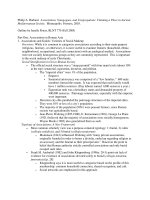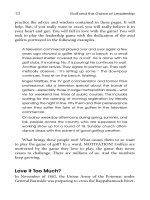Tài liệu Associations and Guilds: Varieties of Social Makeup pptx
Bạn đang xem bản rút gọn của tài liệu. Xem và tải ngay bản đầy đủ của tài liệu tại đây (121.42 KB, 17 trang )
Philip A. Harland. Associations, Synagogues, and Congregations: Claiming a Place in Ancient
Mediterranean Society. Minneapolis: Fortress, 2003.
Outline by Janelle Peters, RLNT 770 (Fall 2005)
Part One: Associations in Roman Asia
1. Associations and Guilds: Varieties of Social Makeup
Overview: While it is common to categorize associations according to their main purpose
(religious, funerary, or otherwise), it is more useful to examine features (household, ethnic,
neighborhood, occupational, and cult connections) with an analogical method. Associations
were not socially homogenous groups as they are commonly represented. This is important
to the social makeup of early Christianity.
Social Stratification in Greco-Roman Society
•
The official social structure was a “steep pyramid” with four main levels (about 10%
at the top): senatorial, equestrian, decurion, and plebian.
o
The “imperial elites” were 1% of the population.
Emperor
Senatorial aristocracy was comprised of a “few families.” 600 male
members formed the senate. It was expected that each family would
have 1 million sesterces. (Day laborer earned 1,000 sesterces a year.)
Equestrian rank was a hereditary status and demanded property of
400,000 sesterces. Patronage connections, especially with the emperor,
were important.
o
Decurion city elite paralleled the patronage structures of the imperial elites.
They were 10% or less of a city’s population.
o
The majority of the population (90%) were peasant farmers, since Roman
society was agriculturally based.
o
Jean-Pierre Waltzing (1895-1900), E. Kornemann (1901), George La Piana
(1921) believed that the majority of associations were socially homogenous.
Wayne Meeks (1983) also generalized them as such.
Typology of Associations: A New Framework
•
Most common scholarly view was a purpose-centered typology: 1) burial, 2) cultic
(collegia sodalicia), and 3) burial (collegia tenuiorum)
o
Mommsen (1843) influenced Waltzing with “many private associations,
originally founded in order to honor a divinity, ended up regarding religion as
an accessory and the funeral as their principal aim.” Based on the point in
belief that Roman authority strictly controlled associations and only burial
escaped such rules.
•
Frank M. Ausbuttel (1982) and John Kloppenborg (1996a: 20-3) point out lack of
evidence for existence of associations devoted solely to burial (collegia tenuirum,
funeraticia) [p. 28]
o
Kloppenborg says it is more useful to categorize based on the profile of this
membership: common household connection, shared occupation, and cult.
o
Social networks are emphasized in this approach.
Harland Outline 2
o
Sociological studies since 1960s emphasize the importance of preexisting
social networks for understanding the formation and growth of social and
religious groups and movements.
•
Five types of associations are important: household connections, ethnic or group
connections, neighborhood relationships, occupation, and cult or temple.
o
Household Connections
In about 160 CE, an association of 400 initiates (mystai) in the
mysteries of Dionysos (an exceptionally large group) honored
Pompeia Agrippinilla.
•
Many of the main functionaries were from the families of
Agrippinilla and Gallicanus (consul 150 CE, proconsul 165
CE).
•
The rest of the members were their dependents. Thus,
heterogeneous membership could be formed because once the
family associations were made, they could naturally expand.
Family networks and structures also were important in the formation
and expansion of early Christian assemblies.
•
Organizational structures are illustrated in architecture. Local
homes were adapted for community use, which led to
leadership and organization of associations, synagogues, and
congregations in the Greek East.
•
Language of family affection occurs in a significant number of
associations that do not involve actual families (contra Meeks).
All female associations of initiates of Great Mother (Cybele) at
Serdica in Thracia referred to leader as “mother.”
o
Jewish group at Stobi in Macedonia honored “father of
synagogue” for donation. [p. 32]
o
Brother language attested in Egypt in athletic
association.
o
Ethnic or Geographic Connections
Asia has many Romans who were from Rome or Italy. Membership
was heterogeneous socioeconomically. [p. 33] Some immigrants
could assume local citizenship, attain wealth, and become known as
benefactors in city of residence (Hatzfeld 1919, Broughton 1938).
Judaeans grouped together as well—some had lived there for decades
or centuries, so it is unwise to overemphasize “immigrant” status (cf.
Josephus, Ant. 12.147-53).
•
Gentiles of varying levels of attachment could affiliate with a
given synagogues (slaves of Jewish families, proselytes, and
God-fearers).
•
Occupational and neighborhood networks influenced some
Jews’ choice of synagogue affiliation. [p. 34]
Individual Jews could sometimes gain citizenship status (Applebaum
1974, Trebilco 1991 note complexities of determining this).
Several groups of Asia Minor emigrants were in Rome.
•
Sardinians met regularly at Rome (I GUR 85, 86, 87).
Harland Outline 3
•
Ephesian shippers and merchants met in Rome (I GR I 147).
•
Phyrgians devoted to Great Mother in Pompeii and Rome (I
GR I 458). [p. 35]
Asians who emigrated to Macedonia, Thrace, and Italy gathered in
Dionysiac mysteries familiar to them at home (cf. Edson 1948, Nilsson
1957).
Contrary to scholarly traditions, extralocal links could play a
significant role in some associations. [p. 36]
o
Neighborhood or Locational Connections
Street, district, or neighborhood dwellers could act together
corporately, becoming an ongoing group with social and religious
purposes. [p. 37]
o
Occupational Connections
Occupation was often interrelated with family ties: it was a common
practice in antiquity for some to follow in their father’s footsteps, but
professional affiliation also led to marriages like the goldsmith at
Laodikeia Combusta who married the daughter of a head goldsmith. [p.
38]
For Paul, occupational workshops played a role in his travels (cf. Acts
18:2-3, Malherbe 1983:89-91 on Acts 19:9, Hock 1980).
While Celsus had his biases, Christians were often from the lower
class. Workshops of wool workers, shoemakers, and clothes cleaners
were integral for some Christian groups (Origen, Against Celsus 3.55).
[p. 40]
Paul had his own handiwork (1 Thess 2:9, 4:9-12; 2 Thess 3:6-15).
Occupational associations were often more homogeneous in
membership. [p. 41]
While the upper class’ disdain for work of any kind is evident from
Herodotus (5
th
c. BCE) to Lucian (2
nd
c. CE), workers’ own
understanding was different. Artisans often identified themselves by
occupation on their gravestones. [p. 42]
Certain occupations might be more conducive to wealth-building than
others.
•
Shippers and traders would have greater prestige than local
tanners whose work involved undesirable odors and clothing
cleaners whose labor by nature involved burning of sulfur and
urine (cf. Lucian, Navigation; Philostratus, Life of Apollonius
4.32; D’Arms 1981).
•
Purple-dyers would have more wealth than regular clothiers,
though any level of production could include ex-slaves (cf.
Pleket 1983: 139-40; New Docs 113).
•
In cities like Ephesus, silversmiths or goldsmiths could do well.
One silversmith was on Artemis sanctuary’s board of
management.
•
Physicians could acquire wealth. [p. 42]
Harland Outline 4
Some occupational guilds could have had women in their ranks. Lydia
the purple-dye from Thyatira (Acts 16:11-5) and Elpis the purple-
dealer at Kos, alongside a fellow worker, could be candidates. 2
women at Athens in 4
th
c BCE joined fellow clothing workers in
dedicating monument to nymphs and all the gods.
Ephesus fisherman and fish dealers show diversity in size of donation
to building fishery tell office. Also some were citizens, others were
not, others were slaves. Thus, it was possible for heterogeneity in
wealth among members, even in occupational associations.
o
Cult or Temple Connections
Honoring gods and goddesses was important to all associations but
some had this concern as their raison d’etre.
Array of associations in Asia during the Roman era: Apollo, Aphrodite,
Artemis, Asklepios, Cybele and Attis, Zeus, emperors (Sebastoi), as
well as messengers of the gods (“angels”) or heroes. [p 44]
•
Men (Phyrgian moon): primarily free or peasants from
occupations, solely male or mixed
•
Sabazios (Phrygian, sometimes associated with Dionysios):
men predominate, lesser economic means might be indicated
by the poorer quality writing on their inscriptions.
•
Initiates (mystai) in mysteries were honoring the gods in one of
the most respected ways. “Mysteries” covered a variety of
practices: sacrifice, communal meals, reenactment of myths of
gods, sacred processions, and hymns.
•
Egyptian Isis and Serapis were well-attested. Apuleius’
famous description of a procession in honor of Isis suggests the
importance of women (Metamorphoses, bk 11)
•
Sharon Kelly Heyob (1975) points out that only 18.2% (200 of
1,099 inscriptions) mention women as priestess, member, or
devotee.
•
Eleusinian Demeter and Kore were especially evident at
Ephesus, Smyrna, and Pergamum. [p. 45]
•
Dionysos is the best attested. The foundation myth of maenads
in 3
rd
c. BCE legitimated by oracle at Delphi is found in a 2
nd
c.
CE inscription at Magnesia by Maeander River. It remained
important in the Roman era, even though groups were mixed
(men and women).
o
A group in Smyrna had purity regulations, showing
influence by Orphic dietary practice. [p. 47]
o
Cowherds at Pergamum were primarily men and about
35% of them were Roman citizens.
o
Epitaphs from Asia Minor and from Italy indicate that
children could lead dances and speak rites,
corresponding to the prominence of childhood in
Dionysiac myths. [p. 48]
Diversity is also found in Jewish associations.
Harland Outline 5
•
Some Gentiles adopted practices associated with the Jewish
God in 1
st
c. CE (cf. Acts; Josephus, Ag. Ap. 2.282).
•
“Most High” associations in cities of the Bosporous have been
shown to be related to Gentile worship of the Jewish God. The
leader was called a synagogos.
•
4
th
c Church Fathers (Epiphanius, Gregory of Nazianzus)
complained about proseuchai that were comprised of neither
Christians nor ethnic Jews.
•
Christian congregations were devoted to the Jewish god. [p. 50]
In the 1980s, scholars began to move away from the notion that
Christianity was solely a lower class movement.
•
Pliny the Younger had “individuals of every age and class,
both men and women” brought before him as Christians
(Epistles 10.96.4,8-9).
•
Inclusion of household codes giving advice to both men and
women suggests the presence of both groups (1 Peter, Pastoral
Epistles, Ignatius’s epistles).
•
Pastoral Epistles, Johannine epistles, and Ignatius’ epistles
mention wealthier figures who assumed leadership of
congregations. [p. 51]
•
While the Christians in Smyrna appear to have drawn a greater
proportion of membership from lower classes, those in
Laodicea had considerable wealth. [p. 52]
Conclusion: Many unofficial associations had membership from heterogeneous nonelite
groups. Five types of composition are useful in examining the membership of these
unofficial associations. While this study has focused on Roman Asia, other studies have
come to similar conclusions for other areas in the Roman Empire. [p. 53]
2. Internal Activities and Purposes: Honoring the Gods, Feasting with Friends
Overview: The imperial dimensions of group life did not stand in isolation nor were they
the only important feature. The general functions of associations are shared by Jewish
and Christian groups, making them part of this category despite the peculiarity of their
monotheism. [p. 53-4]
Visualizing Association Life
•
Monuments in Mysia depict actual activities of the associations. The gods Zeus,
Artemis, and Apollo hold the customary libation bowl in their right hands, while the
six members of associations on a smaller scale recline to share in the banquet.
•
Sacrificial offerings for the gods and other forms of worship were also important. [p.
57]
Questioning a Scholarly Tradition
•
One stream of scholarship (M.P. Nilsson, Ramsay McMullen, Nicholas R.E. Fisher)
separates the social from the religious. [p. 59]
o
Nilsson saw the associations as using the god as a pretext for feasting, finding
the mysteries “pseudo-mysteries.” [p. 59]
o
MacMullen emphasizes the feasting and friendship associations over against
the cosmological significance of the feast itself.
Harland Outline 6
o
Fisher finds the main purpose of collegia to be “status, solidarity, sociability,
and other aspects of social security” (1988b: 1222-3). [p. 60]
•
Harland’s working definition: “‘religion’ or piety in antiquity had to do with
appropriately honoring gods and goddesses (through rituals of various kinds,
especially sacrificial offerings) in ways that ensured the safety and protection of
human communities (or groups) and their members.”
Intertwined Social, Religious, and Funerary Dimensions of Association Life
•
Religious Activities [p. 61]
o
Inscriptions are limited in the information they provide because they take for
granted customary practice (which is precisely what scholars want to know).
o
Dream books of Artemidorus Daldis (in 2
nd
c. CE Ephesus) provides evidence
that those in a common occupation often devoted themselves to a particular
deity. [p. 62]
o
Silversmiths of Acts 19:23-41 would simply be protecting the landscape of
their dream and waking life and would not be exceptional.
Building remains of guild halls in Italy have sanctuaries and feasting
facilities, showing the interrelation of social and religious activities
within guild life. [p.63]
Ethnic based guild on Greek island of Delos illustrates the importance
of cultic functions; its concern to honor other deities is shown by
inclusion of their statues. [p. 65-6]
Teira (near Ephesus) epitaph makes a provision for guild workers to
hold a yearly wine banquet. [p. 69]
Inscription of Ephesus synedrion of physicians refers to the guild as
“physicians who sacrifice to ancestor Asklepios and the Sebastoi” (I
Eph 719). [p. 69]
o
Religious festivals and gatherings to honor the gods were a common feature of
group life; they could include a number of different rituals and practices,
including mysteries. Walter Burkert’s (1987) study rightly emphasizes that
mysteries did not exist over against other religious life. [p. 70]
o
Individuals and groups took honoring the god appropriately very seriously.
One of the “confession inscriptions” (Beichtinschriften) of Asia Minor
says the man from Blaudos (east of Philadelphia) is punished by the
god “because he did not want to come and take part in the mystery
when he was called” (MAMA IV 281 = Petzl 1994: 126 no. 108; 1
st
-2
nd
c. C.E., from Dionysopolis).
Rare instances of exclusivism did occur, as when therapeutai of Zeus
at Sardis were “not to participate in the mysteries of Sabazios… and of
Agdistis and Ma” (ISardH 4 = NewDocs I 3; 2
nd
c. C.E.). [p. 71]
o
Singing and music could be important in associations, congregations, and
synagogues.
Organizations of boys, girls, or youths who regularly sang commonly
appeared in civic cults and festivals.
Orphic hymns, probably from western Asia Minor (Pergamum), refer
to Dionysiac initiates and singing cowherds.









